McMurtry LEED gold certified before dedication
Just in time for its dedication, McMurtry College became the second new building at Rice to receive Leadership in Energy and Environmental Design Gold certification, the U.S. Green Building Council's second-highest designation.Named for Burt (Baker '56 and '57) and Deedee (Brown '56) McMurtry, the 10th residential college incorporates several environmentally friendly features into its design. McMurtry gained LEED Gold-certified status on Oct. 5 and was dedicated on Oct. 29.
The most visible LEED installments at McMurtry are bathroom pods that contain water-efficient fixtures, such as dual-flush toilets and low-flow shower heads. Director of Sustainability Richard Johnson said Facilities, Engineering and Planning estimates the pods use 40 percent less water than normal facilities, amounting to roughly 1,250,000 gallons per year at the college. A manufacturer assembled the pods off-site to reduce construction waste.
In addition to the pods, McMurtry houses a covered bicycle parking area able to accommodate up to 60 bicycles, an effort to promote alternative modes of transportation, and EnergyStar front-loading washing machines.
Johnson said each room at the college is equipped with motion detecting light sensors and air conditioning and heating sensors that connect to the windows to prevent excessive heating and cooling loss from leaving the windows open.
"We didn't want to cool the outdoors," Johnson said.
According to Johnson, the automatic sensors' efficiency exceeds the required energy code by as much as 35 to 40 percent.
Behind the scenes, double-paned, low-emissivity glass that reflects thermal radiation provides big energy savings for the college, Johnson said. For example, by reducing heat transfer through the windows, students have less need to cool their rooms during a hot summer day.
In addition, the windows provide additional sources of lighting.
"The windows provide a lot of natural daylight in rooms," Johnson said. "Students don't need to turn on lights as often."
Furthermore, the external college walls are two bricks thick, providing an extra level of thermal insulation during the winter, Johnson said.
Manager of Communications for FE&P Susann Glenn said one of her favorite parts of the new college's sustainable design is the green roof, one of seven at Rice, that reduces the heat transferred into the building through evaporative cooling, reduces stormwater runoff and creates natural habitats.
In some cases, environmental efforts came down to the materials used to build the college. Johnson said normal Portland Cement used in mixing concrete creates a high carbon dioxide footprint. Instead, FE&P substituted recycled materials - like fly ash and slag - with a smaller carbon footprint to reduce the use of Portland Cement.
The amount of fly ash and slag substituted for Portland Cement represent the largest undertaking of its kind in the U.S., Johnson said.
"It's the first time something like this has been done in the U.S.," Johnson said. "The architects brought the idea from their work in Europe, and the contractor was open to innovative ideas."
FE&P also chose to incorporate simple finishes into the floors to avoid excessive use of paint and adhesives, Glenn said.
Before, some students with sensitivities to certain chemicals had experienced problems with moving into new colleges, Glenn said.
"The [simply finished] rooms are excellent for people with allergies or asthma," Glenn said.
Johnson added that more materials typically lead to lower air quality, which is already two to three times worse indoors than outdoors.
"The greenest material is the material you don't use," Johnson said.
Local and recycled materials contributed additional points to the building's score, as 21 percent of materials used came from within 500 miles, and 14 percent of the materials, as measured by cost, came from recycled content, Johnson said.
Originally, FE&P had planned to submit West Servery together with McMurtry for review by the USGBC for certification. Johnson said that, upon further review, FE&P decided to let McMurtry stand alone and not pursue certification of West since LEED requirements make it harder for energy-intensive buildings like the serveries to obtain any certification.
Johnson said FE&P waited to receive Duncan's feedback from the USGBC before submitting McMurtry's paperwork.
Although Johnson said he had anticipated Silver certification for the college, extra measures taken by FE&P ultimately provided enough points to allow McMurtry to attain Gold certification.
While the Gold certification was pleasant news, Johnson said it was not a complete surprise.
"The Duncans' gift challenged us to think beyond LEED Silver certification," Johnson said. "When we saw we could get Duncan [College] LEED Gold certified, we said, 'Why not pursue the same features with McMurtry?'"
To obtain LEED certification, a building must be designed to meet a series of 110 possible points, with 80 points needed for the highest rating of platinum, 60 points for a gold rating, 50 points for a silver rating and 40 points for basic certification. USGBC awards points to buildings in the categories of sustainable sites, water efficiency, energy and atmosphere, materials and resources, indoor environmental air quality, locations and linkages, awareness and education, innovation in design and regional priority.
More from The Rice Thresher

Rice announces Chao College as 12th residential college
Rice announced that the 12th residential college will be named Ting Tsung and Wei Fong Chao College Aug. 19. The college, set to open in fall 2026, will contain nearly 300 on-campus beds.
Dining access fund announced following on-campus unlimited meal swipes
Rice announced new food assistance programs on Tuesday to account for the controversial change in the on-campus meal swipe plan.

Rice disaster prediction model discussed at hearing on deadly Central Texas floods
The House and Senate Select Committees on Disaster Preparedness and Flooding held a hearing on July 31 in Kerrville to address the deadly July 4 flooding in Central Texas. The flooding along the banks of the Guadalupe River killed 108 people, including 37 children. In the charged hearing, Texas lawmakers and flood survivors criticized the local response to the disaster.


Please note All comments are eligible for publication by The Rice Thresher.